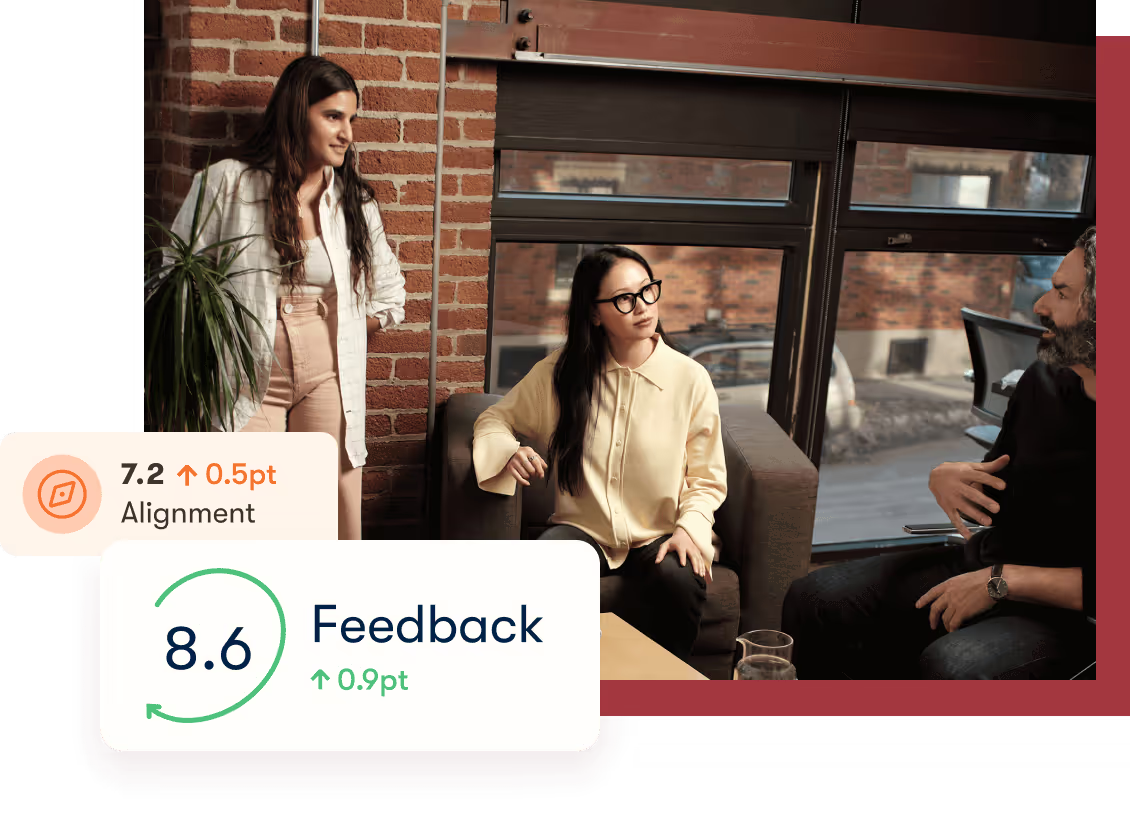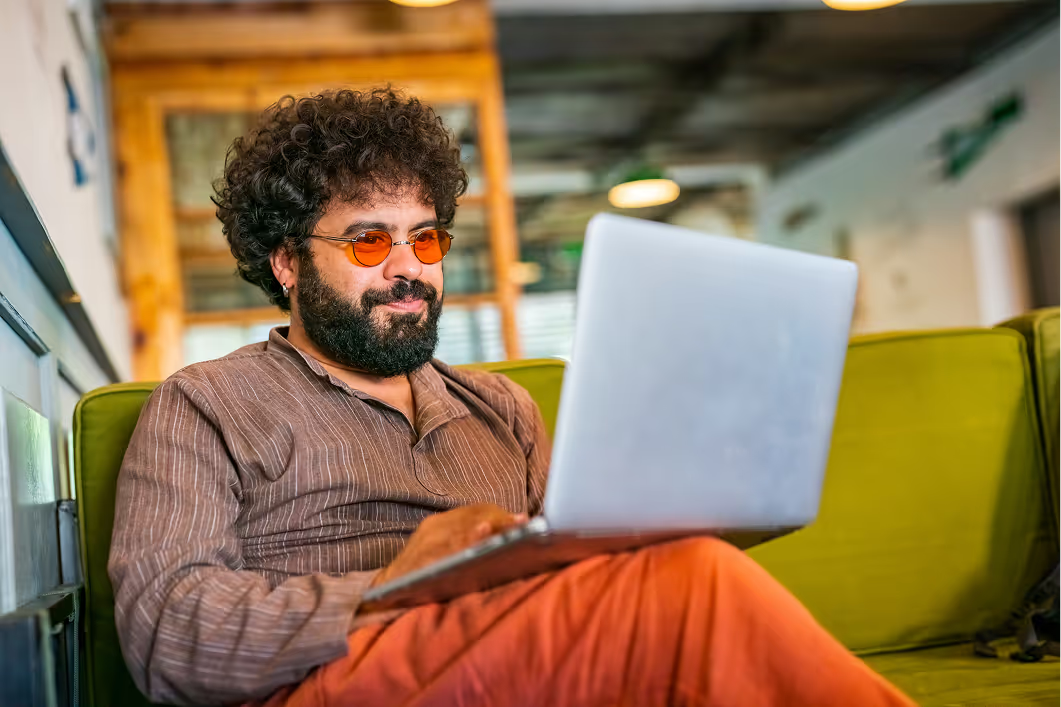Build an employee engagement action plan in 7 steps

Discover Workleap Officevibe's benchmark report on 12 key employee engagement metrics

As a manager, engaging your team is a non-negotiable if you want your employees to thrive in the workplace. Nowadays, skilled professionals are seeking the full package when it comes to their employee experience. This extends far beyond simply earning a livable wage; it includes finding purpose in your day-to-day, believing in your company values, and having a healthy work-life balance.
But engagement doesn’t just happen. It comes from collecting genuine feedback from your team and having honest conversations to see what’s working well and what’s holding people back, then working to emphasize the positive and improving the more challenging parts. Listening to your team shows them that you’re dedicated to keeping them happy and engaged, and empowers them to show up and do their best work.
This is your employee engagement action plan.
The benefits of employee engagement
The benefits of managing a team of highly engaged employees are countless. Aside from higher employee productivity, your team will see:
- Higher employee retention
- Achieved collective objectives
- Less workplace stress
- Lower absenteeism rates
- Increased company profitability
Simply put, improving employee engagement is a vital part of developing high-performing teams. Read on to discover more benefits of employee engagement.
What is an employee engagement action plan?
Every great manager wants a team full of inspired, driven, and engaged employees. An employee engagement action plan can help leaders better motivate and stimulate their teams. As a manager, you can create an employee engagement action plan by assessing where engagement might be falling short, and then developing employee engagement strategies to improve those areas.
There is no one-size-fits-all employee engagement strategy, so your plan will depend on factors like your company's:
- Size
- Industry
- Work model
- Mission and vision
- OKRs
Just as teams, business goals, and strategies evolve and fluctuate over time, so do levels of engagement. That’s why a great employee engagement action plan isn’t just a one-time thing. Once you start taking action to improve engagement on your team, it becomes a regular part of maintaining team health and well-being.
Building an action plan to keep your employees engaged is an important step in improving employee morale and job satisfaction. Learn how to create the best employee engagement plan for your team with the steps outlined below.
How to build an employee engagement action plan
Step 1: Collect feedback through employee engagement surveys
Before you can start making any improvements or reassessing your objectives, you need to identify what might be keeping employee engagement on your team low, and what your people think is working well.
Sending your team a regular employee engagement survey is a great way to understand their experience and get employee feedback. When you analyze the survey results, you get a clearer picture of what’s bringing your engagement scores up, and what’s bringing them down. You may even spot some areas you didn’t know your employees were struggling with. This is the crucial knowledge that helps you build an excellent engagement action plan for your team.
Step 2: Focus on one thing at a time
Once you’ve sent out your engagement surveys and collected your employee feedback, your next step is to narrow down your areas of focus. Look through your results, choose a couple of areas to emphasize, and try narrowing it down to one metric if you can. This way, you can zero in on specific pain points or opportunities for improvement that could go a long way for your team, rather than spreading your focus in too many directions.
Remember that less is more when deciding which metrics to prioritize. The narrower your focus is, the more opportunity you have to make positive, impactful changes. If you’re unsure where to start, pay attention to the results that have the highest and/or lowest percentages, or focus on the metrics that tend to fluctuate more.

What should you keep an eye on while gauging employee engagement? Learn more about the top engagement metrics and sub-metrics every manager should watch out for.
Step 3: Define your employee engagement goals
When you've identified pain points keeping employee engagement low through your survey results, it's time to define and create specific team goals to reinspire your people. Clearly outline what you'd like to accomplish, which employee engagement initiatives will help you get there, and what the desired short or long-term objectives are.
Remember: if you want to meet your goals, they have to be realistic. Setting unattainable lofty goals and timelines can result in disappointment and further disengage your employees.
Step 4. Make the action planning process a team effort
You can’t make a great employee engagement plan without the help of your team. It’s important to get them involved early because many employees feel a disconnect between their experience and their manager’s perception.
1 in 5 employees feel a disconnect from their managers and wish for more frequent communication.
Officevibe Pulse Survey data
Start by working together to understand the engagement issues the team is facing before tackling them. From there, you can brainstorm solutions together and have everyone take on some action items in your plan. Developing an engagement action plan can help you foster a sense of togetherness and understanding in your team. By leaning into the specific key engagement drivers for your team, you'll learn what really drives your employees to succeed.

You can dig deeper into issues by discussing survey results in one-on-one meetings with employees. This helps you understand the employee experience and follow up on action items you set together. Officevibe helps you do this easily by turning engagement metrics into one-on-one talking points.
Step 5. Once you’ve got everything together, make an action plan
Now, it’s time to put your employee engagement initiatives into action. With data from your employee surveys, a better understanding of your team’s experience, and the ideas you came up with altogether, you’re ready to build your plan.
It’s important that all hands are on deck to get the most out of your engagement plan. Give your team members the opportunity to take on action items for themselves or volunteer to carry out certain tasks. While your team should consistently work on collective engagement action items, make sure this doesn't overwhelm them or add to their workloads. These employee engagement initiatives should ideally flow seamlessly into your day-to-day operations.
Step 6. Regularly follow up on the plan’s progress
For any manager, genuine open communication with your employees is key. As you roll out your engagement plan, keep your team posted on your progress and ask for their thoughts on an ongoing basis by implementing a feedback loop.
If you hit roadblocks together or things don’t go according to plan, make it a discussion and see how you can reassess priorities or try something else. Keep in mind that you may need to continue refining and changing your approach; sometimes when one engagement area is addressed, another focus area emerges. This is normal, and precisely why you want to maintain ongoing communication with your team.

Step 7. Keep measuring employee engagement metrics
Above all, remember that improving employee engagement doesn’t have a finish line – it's an ongoing process. These plans are designed to be continuous, and further evaluations and adjustments will eventually need to be made if you want to measure progress on your team. Don’t be afraid to reevaluate your engagement plan every month or two, set new goals, and tackle new metrics.
Sending out pulse surveys that cover the same metrics and asking employee engagement questions on similar topics can help you see how much positive change has resulted from your plan. Pulse surveys help you easily spot any fluctuations or trends because they measure the same metrics over time. Officevibe's Pulse Surveys are quick to answer and reports are easy to read, so they never take time away from you and your team doing what you do best.
[ov_cta id="5116869"]
Examples of employee engagement action plans
Let's take a look at some common employee engagement areas that can prove challenging for most teams, and how you can go about building your action plan.
Note that the tables below provide simplified versions of employee engagement action plans. Use these templates as jumping-off points and really make them your own!
Employee well-being action plan
Professional development action plan
An employee engagement action plan for the long-term
You can always take quick steps to improve employee engagement on your team. But the best action plan is one that can be deployed long-term. This doesn’t mean it has to be a significant investment of time, effort, or money – it means it’s something you tend to do over time and adjust as needed.
Recap: How to build an employee engagement action plan for your team
- Review the data and identify which areas to prioritize. You might want to prioritize the lowest-scoring metrics from your engagement survey or any area that’s a current pain point for your team.
- Engage employees in action planning for these challenges. Your team knows their dynamic and workflows best, and have valuable insights on how they might improve things.
- Determine your goals and your endgame. Having a vision of where you want to end up gives you a clearer idea of how to get there. Make sure these goals are realistic and actionable.
- Follow up on progress. If you don't follow up and take stock of whether or not engagement initiatives are working, what's it all been about, then?
And with a sidekick like Officevibe's employee engagement solution to automate most of the work, you’ll be well-equipped to develop a plan that is tailor-made for your team.
But don't just take it from us: read how Officevibe has helped major enterprises like Alithya keep their employee engagement high in this recent interview.
Give HR and managers the clarity, confidence, and connection to lead better every day.


%20(1).avif)


.avif)
.avif)






.avif)

